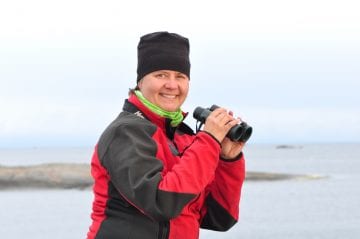Mapping the underwater nature provides tools for the marine conservation and management of marine protected areas

Heidi Arponen,
Marine Conservation Biologist,
Metsähallitus Parks & Wildlife Finland,
Finland
Marine biodiversity is threatened worldwide, due to human activities, and the Baltic Sea is no exception. The effective marine conservation and management of marine protected areas (MPAs) require extensive data concerning underwater species and habitats.
Historically, the knowledge of underwater nature in Finnish coastal seas has been scarce and fragmentary. To remedy emerging needs to know more about marine biodiversity, a Finnish Inventory Programme for the Underwater Marine Environment (VELMU), was launched in 2004, funded by the Ministry of Environment. VELMU is one of the largest, if not the most extensive, seabed mapping efforts in the Baltic Sea with over 140,000 observations made using scuba diving, underwater video filming and seabed acoustic scanning, as well as various benthic sampling methods. A large portion of the biological inventory work was conducted by the mapping teams of Metsähallitus Parks & Wildlife Finland. In addition to the VELMU programme, there have been several smaller EU-funded projects undertaking underwater inventories under the umbrella of national marine mapping effort. Metsähallitus Parks & Wildlife has conducted its yearly underwater inventories inside the conservation areas.
During the period from 2004 to 2017, VELMU-inventories produced a large amount of new information about the geology and biology of the coastal seabed for use in inter al. science, nature conservation and marine spatial planning. Gradually, the emphasis has moved from the extensive mapping of biodiversity towards more targeted species and habitat inventories, as well as further processing of the underwater data. Various computer software programmes enable the analysis of the collected georeferenced data, to produce advanced models of species and habitat distributions or the responses to environmental changes.
In marine areas, various socioeconomic interests meet and overlap. To enhance the sustainable use of the sea, effective marine spatial planning (MSP) requires knowledge of underwater nature values. In 2018, sites of high biodiversity in Finnish coastal areas were identified, when researchers from the Finnish Environment Institute combined VELMU-data with spatial conservation prioritization method Zonation.
The novel information of marine biodiversity hotspots was utilized when, in collaboration with numerous experts, 87 ecologically significant underwater marine areas (known in Finnish as EMMAs) were identified from the Finnish coast. EMMAs were used in national Marine Spatial Planning processes, to consider underwater nature values along with marine protected areas.
Marine inventories have generated more tools for species-specific conservation. For the first time, underwater data enabled thorough inclusion of marine underwater species in the assessment process of the IUCN Red List of Species in 2019. According to estimations, a proportion of marine underwater fauna and flora is endangered due to e.g., eutrophication, habitat degradation, and human-induced pressures. In the 2018 Red List assessment of marine ecosystems, several endangered habitat types were identified, including eelgrass meadows and sea bottoms covered with red algae or bladderwrack. Despite these mapping efforts, the need for even more accurate information still prevails and continues to emerge, since many species and habitat types were assessed as data deficient.
An ecologically effective and spatially comprehensive network of marine protected areas is essential in maintaining marine biodiversity. In Finland, although the network of protected areas is traditionally well developed, it is scattered spatially. The Finnish MPAs consist of Natura 2000 sites, HELCOM MPAs, Ramsar sites, national parks, private MPAs and Nature Reserves. These various types of MPAs largely overlap and differ in their legislative background. Natura 2000 sites form the core of Finnish MPAs. The EU Habitats Directive aims to maintain an adequate conservation status for habitats and species, protected by the Natura 2000 network. The condition of Natura 2000 sites is assessed periodically, and inventory data has brought new tools for evaluating underwater nature types, e.g., reefs, sandbanks, and coastal lagoons.
At present, 11% of Finnish sea areas, including its exclusive economic zones (EEZs) are under protection. According to Zonation analysis mentioned above, less than 30% of marine biodiversity features are covered with current MPAs. This is understandable since little information about marine species and habitats was available at the time most of the conservation areas were established. With enhanced data, conservation efforts can be targeted to better cover the underwater biodiversity, thus improving the functionality and representativeness of the MPA network. Knowledge of underwater nature can be utilised in enlarging existing MPAs or establishing new conservation areas. For example, in the Archipelago Sea, the current Natura 2000 site was enlarged to cover representative underwater reefs, while ecologically valuable eelgrass bottoms were purchased and added to the Archipelago National Park. Inventory data also enables underwater nature values to be included in MPA management strategies, e.g., the management plans of marine national parks.
Through various international and regional agreements, it is required that proportion of protected areas in our seas increases. The EU Biodiversity Strategy (2020) aims to halt biodiversity loss by 2030. In the marine realm, the target is to protect 30% of European sea areas, of which 10% would be protected by strict regulations. Through the comprehensive knowledge of benthic biodiversity gained through extensive marine mapping, Finland is prepared to meet both national and international requirements and to target conservation efforts in areas of valuable marine nature.
E-mail: heidi.arponen@metsa.fi
Expert article 2894
> Back to Baltic Rim Economies 1/2021
To receive the Baltic Rim Economies review free of charge, you may register to the mailing list.
The review is published 4-6 times a year.
